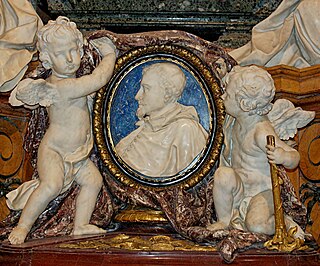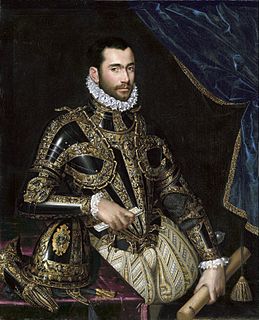
Pope Gregory XIII, born Ugo Boncompagni, was head of the Catholic Church and ruler of the Papal States from 13 May 1572 to his death in 1585. He is best known for commissioning and being the namesake for the Gregorian calendar, which remains the internationally accepted civil calendar to this day.

Ludovisi is the 16th rione of Rome (Italy), identified by the initials R. XVI and located within the Municipio I.

The Ludovisi Ares is an Antonine Roman marble sculpture of Mars, a fine 2nd-century copy of a late 4th-century BCE Greek original, associated with Scopas or Lysippus: thus the Roman god of war receives his Greek name, Ares.
The Casino di Villa Boncompagni Ludovisi is a villa in Porta Pinciana, Rome, Italy. Measuring 2.200 square meters, it is all that remains of a country retreat, best known as Villa Ludovisi, established in the 16th century by Cardinal Francesco Maria Del Monte. The Cardinal was a diplomat, intellectual, art connoisseur, collector, and protector and patron of such very different figures as Galileo and Caravaggio. The Casino is often referred to as the Villa Aurora, after the important fresco by Guercino, located in the Villa's main reception room, depicting the goddess Aurora. One of the smaller rooms of the casino boasts the only painting ever executed by Caravaggio on a ceiling, Jupiter, Neptune and Pluto, which reflects, in symbolic imagery derived from Classical mythology, another of the cardinal's interests, alchemy.

The Gardens of Sallust were Roman gardens developed by the Roman historian Sallust in the 1st century BC. The landscaped pleasure gardens occupied a large area in the northeastern sector of Rome, in what would become Region VI, between the Pincian and Quirinal hills, near the Via Salaria and later Porta Salaria. The modern rione is now known as Sallustiano.

Ludovico Ludovisi was an Italian cardinal and statesman of the Roman Catholic Church. He was an art connoisseur who formed a famous collection of antiquities, housed at the Villa Ludovisi in Rome.

The National Roman Museum is a museum, with several branches in separate buildings throughout the city of Rome, Italy. It shows exhibits from the pre- and early history of Rome, with a focus on archaeological findings from the period of Ancient Rome.

The Duchy of Sora was a semi-independent state in Italy, created in 1443 by King Alfonso I of Naples and dissolved in 1796. It occupied the south-eastern part of what is today Lazio, bordering what is now Abruzzo. Its capital was first Sora, and later, under the Boncompagni family, Isola di Sora.

The Ludovisi were an Italian noble family, originating from Bologna. They had close ties with the Papacy and were influential in the Papal States. Alessandro Ludovisi became a cardinal and later Pope Gregory XV. His cardinal-nephew was Ludovico Ludovisi.

The Villa Ludovisi was a suburban villa in Rome, built in the 17th century on the area once occupied by the Gardens of Sallust near the Porta Salaria. On an assemblage of vineyards purchased from Giovanni Antonio Orsini, Cardinal Francesco Maria Del Monte and others, Cardinal Ludovico Ludovisi erected in the 1620s the main villa building to designs by Domenichino; it was completed within thirty months, in part to house his collection of Roman antiquities, additions to which were unearthed during construction at the site, which had figured among the great patrician pleasure grounds of Roman times. Modern works, most famously Gian Lorenzo Bernini's Pluto and Persephone, were also represented. The engraving of the grounds by Giovanni Battista Falda (1683) shows a short access avenue from a tree-lined exedra in via di Porta Pinciana and cypress-lined avenues centered on each of the facades of the main villa, laid out through open fields, the main approaches to both the villa and the Casino dell'Aurora converging on gates in the Aurelian Walls, which formed the northern bounds of the park; symmetrical parterres of conventional form including bosquets peopled with statuary flanked the main avenue of the Casina, and there was an isolated sunken parterre, though these features were not integrated in a unified overall plan. The overgrown avenues contrasting with the dramatic Roman walls inspired Stendhal to declare in 1828 that the Villa Ludovisi's gardens were among the most beautiful in the world.

The Roman College was a school established by St. Ignatius of Loyola in 1551, just 11 years after he founded the Society of Jesus (1540). It quickly grew to include classes from elementary school through university level. It moved to several different locations to accommodate its growing student population. With the patronage of Pope Gregory XIII, from 1582 to 1584 the final seat of the Roman College was built near the center of Rome's most historic Pigna district, on what today is called Piazza del Collegio Romano. The college remained at this location for 286 years until the Capture of Rome in 1870. In 1873, the remaining philosophical and theological faculties of the Roman College formed the Gregorian University, named after the benefactor of the College in the sixteenth century and thus establishing the link with the previous institution.

Prince Baldassarre Boncompagni-Ludovisi, was an Italian historian of mathematics and aristocrat.

The Boncompagni is an Italian noble family from Assisi.

Giacomo Boncompagni was an Italian feudal lord of the 16th century, the illegitimate son of Pope Gregory XIII. He was also Duke of Sora, Aquino, Arce and Arpino, and Marquess of Vignola.
Filippo Boncompagni was an Italian Cardinal, created by Pope Gregory XIII on June 2, 1572.

Olimpia Aldobrandini was a member of the Aldobrandini family of Rome, and the sole heiress to the family fortune.
Gregorio II Boncompagni was an Italian nobleman and the 5th Duke of Sora. He was the grand-nephew of Pope Gregory XIII

Matthieu Cointerel also known as Matteo Contarelli, was a French Roman Catholic cardinal.

Boncompagni Ludovisi Decorative Arts Museum, Rome, is the Decorative Arts Museum of the National Gallery of Modern Art of Rome. The Museum is located at Via Boncompagni, 18, near the elegant and historical Via Veneto.














